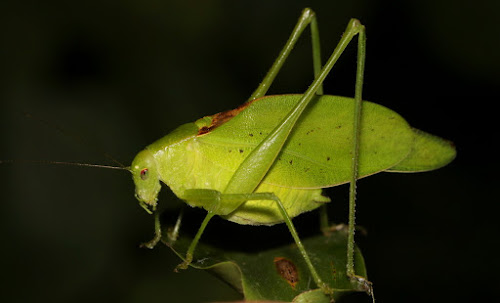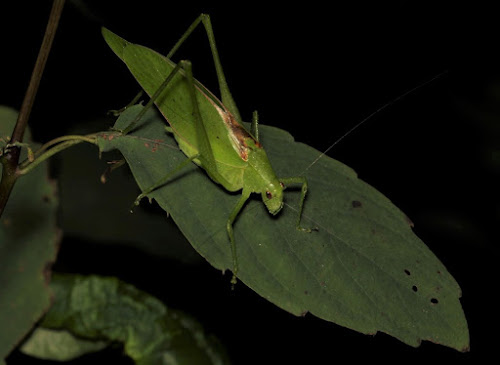It’s the Year of the Oblong-winged Katydid in NE Ohio! I have never heard and seen so many Oblong-wingeds during
field season. Amblycorypha oblongifolia numbers vary from year to year,
as do the numbers of their little cousins, the Rattler Round-winged Katydids (Amblycorypha
rotundifolia.)
But in July and August of 2020 they were by far the most
abundant katydid in the woodland edges, wetlands, and meadows.Their numbers were
especially surprising far out in the open, as they’re more typically in shrubby
edges and woodland understory.
Since they appeared to outnumber all the other singing
insect species except for the ever-present Carolina Ground crickets, this clearly
is the year to profile these beauties.
In NE Ohio, we typically see more of the Scudderia
genus bush katydids – especially the very common Curve-tailed Bush Katydid- than
the Oblong-wingeds. Therefore, people may confuse them, especially with so many
Oblong-wingeds out in the meadows and wetland edges this year.
They’re both large with long, green, leaflike wings. Here’s
a Curve-tailed Bush Katydid's very long, relatively slender wings:
Now look at the Oblong-winged Katydid's wing shape. There is indeed a distinctive bend in the upper wing and they're also wider and a little shorter.
In addition, both the male Oblong-winged Katydid and the male Rattler Round-winged Katydid have a dark
stridulatory field where the male's wings attach to his thorax. This is where the wings' file and scraper produce the insect's songs. The dark color in these two species make a quick gender determination easier.
Male Oblong-winged Katydid.
Katydids in the Amblycorypha genus are called “round-headed
katydids, and it’s true! Look how rounded their heads are – very different from
the Scudderia bush katydids.
Male Oblong-winged Katydid
The Oblong-winged's song can be
described as an emphatic Scritch-IT?! Scritch-it-IT?!
When the temperature drops to what katydids would consider to be chilly after sunset (low 60s or perhaps upper 50s) their songs slow considerably. These are cold-blooded individuals and they can't move -and therefore, sing - as fast at those temperatures and their pitch won't be as high. One recent night at 61 degrees, I noticed that I was actually hearing more wing strokes than usual. Do they always have this many wing strokes that I didn't hear at a faster tempo, or was this unusual?
Oblong-winged Katydid at 61 degrees with a chilly
Sword-bearing Conehead in the background.
Unlike this year, I typically hear multiple males singing
only if there is a female nearby. Elegant and sometimes even a blueish green,
I’ve often found a female posing motionless on a leaf while hearing males all
around her. Each one makes his best enthusiastic effort to successfully
audition with his song while she is onstage.
Female Oblong-winged Katydid. Notice her long, curved ovipositor.
Although woodland edges, understory, and occasionally
wetland edges are the expected places to find these katydids, in this
exceptional year their exclamatory songs have resounded in a chorus from almost
every katydid-friendly habitat.
The Rattler Round-winged Katydid, Oblong-winged’s smaller
relative, is not a species I frequently find in NE Ohio. They seem to appear in
scattered locations, but never consistently or in large numbers. Their
occurrence varies annually, and in some years I may not find them at all. I have
to remind myself that worry may be premature.
Male Rattler Round-winged Katydid
They, too, are woodland edge and understory residents. While Oblong-wingeds occasionally appear in meadows and can be expected
in wetland edges, I almost never find Rattlers elsewhere.
Their very high, soft, delightful songs are not as easy for
some of us to hear. Here’s an example.
At one property I surveyed this year, I saw a couple of
Rattler nymphs in July and did not see any again. I thought perhaps the multitudes of non-native, invasive Chinese mantises had eaten them all, as a katydid
make a fine meal for one of these “preying” mantises.
But to my delight, I finally heard, then saw, a Rattler perched right out in the open on
top of a low, dense mound of blackberry. Here he is, and here's his song:
Within a couple of minutes, I realized that two more males were nearby on the same thorn-filled stage. Rattlers often hide under the leaves but occasionally sing from an upper surface to advertise for females.
Like male Oblong-wingeds, male Rattler Round-wingeds also
have a dark stridulatory field. Both species have round heads, as they are Amblycorypha.
I brought one of that trio of male Rattler Round-wingeds home to compare with the Clicker Round-winged Katydid I was given last year. (See my post about this species for a visual comparison.) Clickers (Amblycorypha alexanderei) don't seem to be present in NE Ohio. They’re not a species I ever hear and the two are visually identical so I wouldn’t be able to tell by sight. I had hoped for an opportunity to study a Rattler’s behavior after living with the Clicker last year, but could not assume that finding multiple Rattlers would even be possible.
The Rattler does look identical to the Clicker and his
behavior is very similar. He’s not at all timid or nervous, appearing to move
with the elegant restraint of a Baroque dancer among the lush vegetation in his
butterfly cage.
While attending to the plants in his cage on the dining room table,
though, I can’t assume he won’t decide to travel outside his cage any more than I could assume this of Clicker. He may suddenly
spring in an athletic jump that propels him airborne into beautiful fluttering
flight across the dining room. Or perhaps he’ll simply jump onto me, attaching
himself to my cheek with his scratchy, tiny feet – or completely surprise me by
leaping up into my hair, as the larger Oblong-winged has also done.
Unintentionally accessorizing with an Oblong-winged
The Oblong-winged’s legs and wings are significantly larger.
He has easily jumped from his butterfly cage directly to the top of my head.
The evening he decided to fly, he didn’t take just a quick trip from the dining room
table to the top of the lower window. He took a vacation. Using the same
jump-and-extend-the-wings takeoff as the Rattler, the Oblong-winged repeatedly circled the dining room and
then confidently flew into the hallway, ultimately landing at the edge of a
bathroom shelf. It was easy to see how one could fly around a meadow or wetland
to suitable vegetation while the Rattler would stay hidden in the understory.
By the end of August, the number of
Oblong-wingeds was beginning to diminish to more expected levels. Life for crickets
and katydids is short, and they are frequently predated or eaten.
I know that frost and ultimately a freeze will come to my
Geauga County survey sites before the end of singing insect season occurs
closer to Lake Erie’s warm water. The meadow-dwelling tree crickets matured
later than usual this year and are now becoming the center of the singing
insect sound stage. Jumping Bush Crickets just began to sing two weeks ago and
the late-season Round-tipped Coneheads have only recently reached adulthood.
Please, September, be kind…


















Interesting. Thanks for all your passion and work!
ReplyDelete